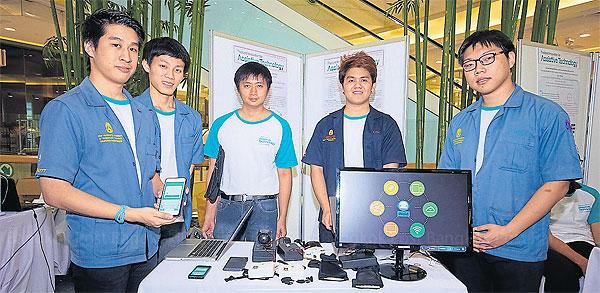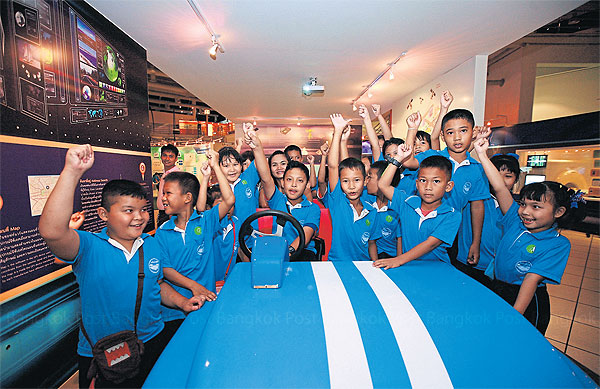
The iNoid team from King Mongkut's University of Technology Thonburi with its invention.
Science and robotics are increasingly being used to help patients with disabilities
Students in engineering and computer science have moved on from just creating robots that can play soccer or other sports.
The Thailand Innovation for Assistive Technology Challenge (TIAT) at Chamchuri Square is the latest move in science, technology, engineering and maths education and robotic studies that enables students to apply their knowledge to serve society and design innovations that serve patients. This year's winners were the iNoid team from King Mongkut's University of Technology Thonburi and Biomax team of Chulalongkorn University.
Patchra Rojanadickhun, an iNoid team member, noted that the innovation of iNoid was based on the Internet of Things concept. The system, also called iNoid, is a walking assistive device for patients suffering from hemiparesis (a weakness on one side of the body).
The team has developed four separate modules to support the way patients walk. These include a device attached to the patient, a home-based device, a sensor that primarily stores data sent from home-based devices and an Application Programme Interface that takes the data storage received from the sensors to be used by hospitals or patients' relatives.
"Each device functions separately, but they work connectedly. The device attached to the patient is a sensor attached on the feet or on the chest. If the patient falls down, it will alert the home-based device and mobile device of the patients' relatives," explained Patchra, adding that the mobile app, called iStroke, is now available on the App Store.
There are also a number of add-on features that addresses patients' individual needs. "Each hemiparesis patient has a different need, and each of these four modules consists of certain devices and components so that it eventually serves the specific requirements of each patient," Patchra added. The team has also developed a website to help hospitals with patient registration.
The TIAT national contest is a collaboration between Seagate Technology (Thailand), a data storage company, the Thai Robotics Society, Sirindhorn National Medical Rehabilitation Centre and the National Science Museum Thailand. It offers contestants a platform to learn and share ideas about the best practices by doctors, therapists, engineers, scientists, designers, robotic professionals and academia.
According to Sirirat Euaypadung, vice-president of Teparuk Operation, Seagate Technology (Thailand), TIAT aims to give the next generation a better understanding of disabilities and how the use of assistive and rehabilitative technologies can help improve the quality of life for people with disabilities.
"The contest was launched at the end of 2014, and over 200 university students participated," said Sirirat. "The contest comprised two workshops and the first round of design presentation took place in the middle of January. Eight teams from six leading universities in Thailand entered the final round. Each team applied the judging committee's advice for research and improvement."
The challenge allows Thai university students to develop research-based innovations that will prevent stroke survivors from fall-related injuries.
Workshops were held to allow information sharing on advanced technologies, equipment, techniques and other related issues in the field of assistive technology for disabled patients.
As a result, contestants not only learned about engineering and science, but the whole process and all aspects of designing equipment to match the need of the patients.

The 'Science Studies' camp focused on providing children with hands-on, extracurricular learning experiences from exhibits in the National Science Museum.
Inspiring junior scientists
Seagate Technology has also partnered with the National Science Museum (NSM) on two recent projects, entitled “Science Studies with NSM and Seagate” and the “Science Cultural Camp”, to spark young people’s interest in science and technology.
Seagate hopes that the projects, both under the theme “Hello Robot”, will lead to more young Thai people pursuing science and technology in higher education.
The Science Studies with NSM and Seagate project provided more than 2,000 students from nearby provinces with hands-on, extracurricular learning from exhibits in the Science Museum, Natural History Museum and IT Museum. This level of interaction, along with various activities, showcased how science and technology are integrated in daily life.
The Science Cultural Camp, on the other hand, welcomed 50 participants currently in Mathayom 1-3 to a three-day, two-night camp. The young students lived in the NSM compound and participated in interactive, inquiry-based classes taught by NSM and Seagate staff along with Science, Technology, Engineer and Math (Stem) educators. Campers had the opportunity to learn about the historical development of various communications tools. They were required to build robots for practical use and learned about the utilisation of various types of sensors. In addition, they had the opportunity to sharpen their skills in developing simple computer programmes to communicate effectively with their robots. They were also encouraged to design and innovate both manually controlled and automated robots.
Sirirat Euaypadung, vice-president of Teparuk Operation, Seagate Technology (Thailand), noted that as well as allowing the young participants to make new friends, they also learned how to work as a team.
“We hope that these young people will experience the beauty of science and technology and ultimately pursue careers in these interesting fields. We would like to equip our new scientists, mathematicians and engineers with the innovative skills to ensure a sustainable development for our country’s future,” she said.


